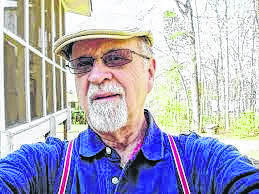A week or so ago a friend of mine, I’ll call Brad traveled with me to the Kazoo Museum in Beaufort, SC to take the factory tour, and pick up two kazoos I had reserved by phone.
We left my house at 7 am, drove straight through except for a bathroom break and some cheese popcorn in Santee. We rolled into the parking lot just as the 11 a.m. tour was beginning.
Our presenter, whom I’ll call “Ben,” had already started a video, showing some fancy kazoos that his company had made.
Then, working without notes of any kind, he began showing us a cart full of breath-powered instruments.
“The most democratic of instruments,” Ben smiled after he tooted a blue kazoo. “Anyone who can hum can play it.”
“Kazoos have been shaped like this for over a hundred years,” he continued. “Like a submarine with a turret. The first ones were metal, and we sell metal ones made in the original factory in Eden, NY. But our own Kazoobies are made of plastic.
“Usually, you play through the big end,” Ben smiled, then hummed a bit of “Stars and Stripes Forever” into the big end. He turned the kazoo around and played.
“The big end just sounds louder,” he smiled.
“The heart of a kazoo is inside this turret,” Ben said, then pulled off the cap, and beat the kazoo against his open hand.
A translucent disc fell out, which Ben held up on his fingertip for us to see.
“This little disc makes the buzz, when you hum into the kazoo.”
“Some kazoos use discs made of coated paper,” he continued “like waxed paper.” He paused.
“Paper discs will lose volume, if they absorb moisture from your breath.”
“This plastic disc sounds better than treated paper,” he said. “It’s medical grade plastic— buzzes really well. And moisture won’t hurt it.”
“You can even toss the whole kazoo in the dishwasher, he continued, “it’ll come out clean, and still sound great.” He paused, then continued.
“We’ve designed some attachments to add to the basic kazoo,” he said, as he picked up a green trumpet bell, then pushed it onto the small end of his white plastic kazoo.
He tooted the kazoo with the bell, then without it.
“Doesn’t make much difference in the sound,” he smiled. “But it looks cool anyway.”
Next, he held up a white, L-shaped plastic bell, shaped like the end of a tuba. He pushed its small end into the turret of the kazoo, then hummed into it.
That’s the loudest kazoo I have heard in my entire life,” I said to Brad. “I need one of them.”
“We call this the “Wazoo,” Ben smiled.
After showing us some other noise-makers like trumpet-shaped kazoos made in England, as well as sirens, police whistles, and slide whistles, Ben took us to the room where standard kazoos are built.
“The plastic parts are cast in Florida, then shipped to Beaufort for assembly,” he said. “I make the diaphragms here in Beaufort.”
With a custom-built press, he punched out ten diaphragms at a time from long multiple layers of 6-inch wide plastic, then installed one of them in a green kazoo turret, then chose a yellow turret cap to hold the diaphragm in place. After that he placed the kazoo into a heated press to weld the turret cap to the kazoo barrel.
“If a buyer wants custom printing,” Boone smiled, “we have a die made ,outside the plant, then place it into our printer to form an image on top of the kazoo barrel.”
After that we walked back to the museum, all of us but Brad picked out a kazoo barrel, a diaphragm, and a cap, to build our own kazoo. After we placed the diaphragm into the turret, Ben let us weld our kazoos together.
Our kazoos had “I visited the Kazoo Museum, Beaufort, SC” printed on the top of the barrel.
After each maker had played his kazoo, Boone thanked us for coming and invited us to look through the museum and gift shop.
I walked over to speak with Ben. “I really appreciate your enthusiasm,” I said.
“I love this job,” Ben replied. “Best one I ever had. Before this I worked in a warehouse, for a long time.” He paused for a moment.
“Then somehow I got this job,” he continued. “Now I love kazoos.
“I can believe that,” I said.
“I’m a shy guy,” Ben continued.
“Really?”
“I never spoke in front of people before now,” he continued. “But I’ve found that when I’m talking about kazoos, I can talk all day.”
“A job you love is not even work,” I said.
Ben nodded. “I want people to love kazoos like I do,” Boone said, “because playing the kazoo makes me happy.“
“Me, too,” I said. “I think of it as music self-therapy.”
“Ben smiled and nodded vigorously.
After that, Ben found a wazoo attachment for my blue Kazoobie, and the two wooden kazoos I had reserved by phone. I signed the credit card, thanked Ben, and went looking for Brad. Then we headed for the car.
After a while, Brad said. “I’m not a kazoo guy… but I really enjoyed this tour.”
“Why is that?”
“I love what I do,” he continued. “But I have never seen a guy enjoy his work like Boone does.”
“I talked to him while you looked at the exhibits,” I smiled. “I think I know his secret.”
“What is it?”
“I can’t tell you now,” I said, then a few days later I gave him a kazoo, so he could learn Boone’s secret, for himself.

